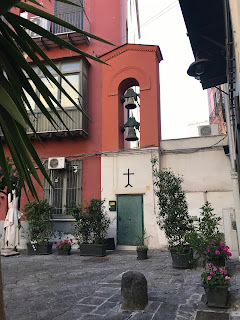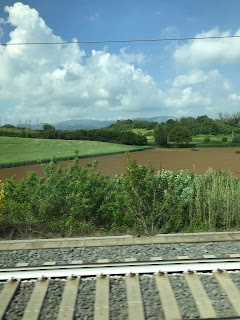Later, he and Helen met with "Mrs Davis of Ind." Mark Emerson, intrepid editor of the Douglasses' travel diaries in the days before digitization, tracked down Mrs. Davis, discovering that she was Hannah Ellen Brown Davis of Spiceland, Indiana, where she and her now-departed husband Clarkson (who had died in 1883), had run an academy.
This "amiable lady," a teacher, raised in the Society of Friends but, according to her memorial, possessing "that catholicity in religion which belongs to real culture wherever it is found," and a lover of literature probably got along quite well with the Douglasses. He certainly impressed her. In the single letter from her to him in the Library of Congress, a Christmas 1889 wish to him while he served in Haiti, she addressed him as "Reverend dear friend," and wrote, "with your weight of cares and perplexities, my thought has often gone in sympathy to you. To how few has it been given to serve their race and nation so long and so worthily. May God's grace return you to your country, your family and friends in safety." But, before that, after the Douglasses departed from Naples headed to Egypt, she composed a poem, "To Frederick Douglass, On His Seventieth Birthday, While in Egypt.":
 |
|
by Hannah E. Davis
|
 |
| Hannah Ellen Brown Davis |
Spiceland lies just outside of Indianapolis, eastward and not far south off of I-70. I lived not far from it for a few weeks, in an extended-stay hotel, when I first moved there back in 2001 to begin work at the Douglass Papers project; but, that is a whole other story -- a few other stories, as a matter of fact. Spiceland also lies not too very far from Pendleton, as well. In his younger days, Douglass had suffered a beating there that had resulted in a broken hand that ached him for the rest of his life.
But, I digress.
Davis joined Frederick and Helen a they went up to another of the highest points in Naples to see "San Martino, a convent of the Capuchin Monks, the largest convent of the kind in the world." He goes on to explain to his diary that, " It is however no longer a living convent. It has been taken possession of by the Government, and its fine halls are now a musium full of paintings and many other interesting works of Art. The church in this old convent is one of the most costly in Europe."
We ourselves saved this for the last day, or last half-day, since we would return to Rome that afternoon and nothing about it in the guide books promised anything that we were dying to see. After all, we were using Naples more as a base to see things around Naples. We had walked up toward Capodimonte on our first day -- not to see Capodimonte but to see the San Gennaro catacombs, which Douglass did not see, or did not write about seeing, but were quite worth a look and which tourist could go visit in those days. We chose to take a cab up to the museum on the day that we visited it, which was a last minute thing and involved changing train tickets and all sorts of boring logistical stuff that has nothing to do with Douglass. I'll just sum up that the cab ride was more fun than a roller coaster.
Anyway, the point here is that, the hill up to Capodimonte rose at less of a grade than the hill up to San Martino, and our fifty-to-sixty year old twenty-first century selves only wanted to make it once.. San Martino looked more like you needed a grappling hook to ascend. To give you an idea in medieval and Renaissance military terms, which Douglass does not mention, but just above the former monastery rises Castle Sant' Elmo. This is from inside its walls:
This is what it looks like from Capodimonte. (The weather in this picture, by the way, was a bit more typical of what we experienced in Italy this time around -- about half the time we were there. To think a heat wave hit the next month.):
Short on time and unwilling to climb the what-must-have-been-five-gazillion steps to get to the top of the hill, we just took one of the several funiculars. I thought it would be more exciting than it was and have views. No, it was just a train, going up a hill, but keeping your seat level, and with the usual views of graffitied walls and overgrown weeds.
How did Douglass and his party get up? Well, according to the Baedeker guide, they could walk up a zigzag road or hire a donkey to an omnibus station. Then, they could ride the bus up an old military road that wound around the mountain. At various points, it seems, they could hop off and take smaller roads or steps the rest of the way up, or they could just take a carriage the whole way.
Frederick, Helen, and Davis went in to see the museum. My companion and I just sat outside, deciding that the price of admission was probably not worth our time. Although the Baedeker insisted that San Martio "is not less remarkable for the beauty of its situation and its views, than for the great value of tis contents," in our different centuries, arriving in our different ways, Douglass, me, and my companion all came to the same conclusion: "I have seen so much of these religious paintings, that I was less interested in what I found here than in the fine view of the city and harbor."
We probably could have seen more had we gone in, but we enjoyed this well enough, and had to be on our way in any case (especially after I took up some time in a cameo shop where the proprietor, charming at first, ended up demonstrating that #MeToo has not reached this corner of Naples).
Whatever Douglass did the next day was either so much fun or far too boring to record. All he wrote was "Heard a strange sermon at the U.P. Church on the greatness of man." That alone leaves so many questions that he never did answer.
--------------------------------------------
Sources:
- Karl Baedeker Firm. Italy. Handbook for Travelers, Third Part: Southern Italy and Sicily (7th, ed.; London: Dulac and Co, 1880).
- Frederick Douglass, Travel Diary, Frederick Douglass Papers, Library of Congress.
- Mark G. Emerson, "Scholarly edition of the grand tour diaries of Frederick Douglass and Helen Pitts Douglass" (Master's Thesis, Indiana University, 2003).
- Others as linked.






































